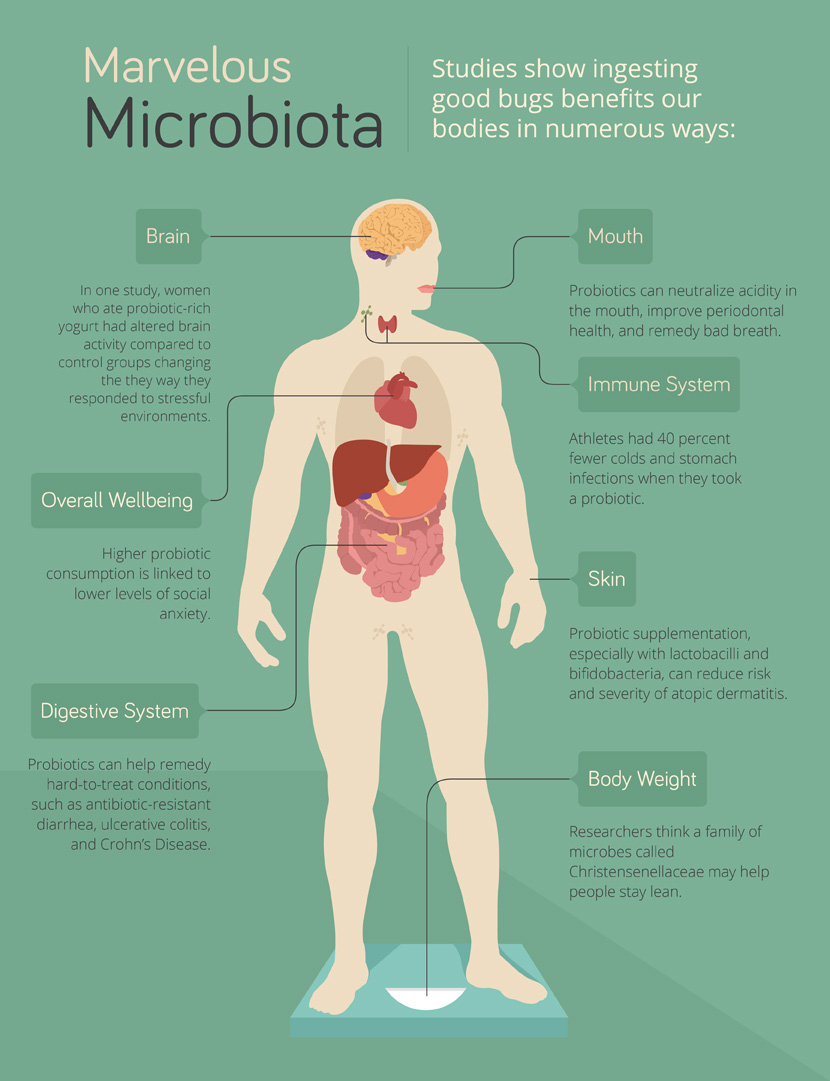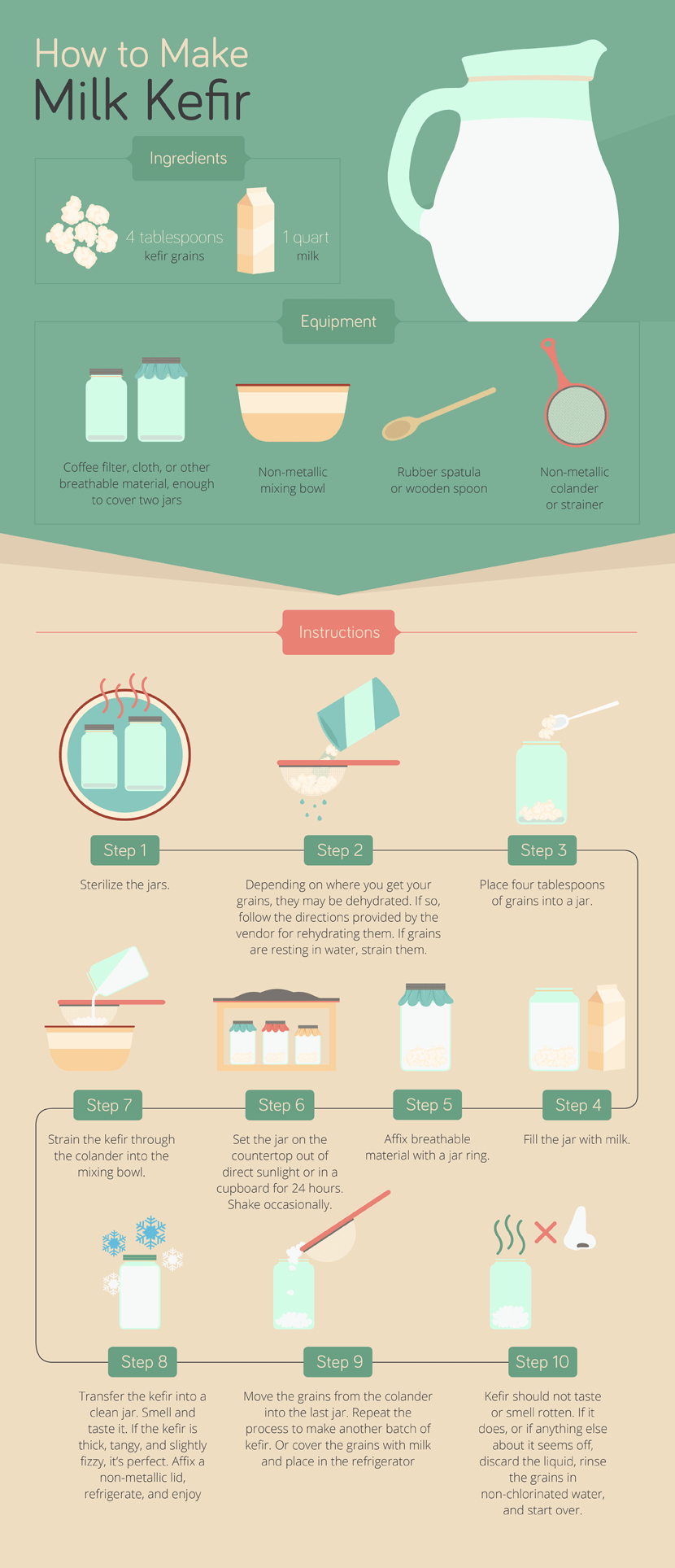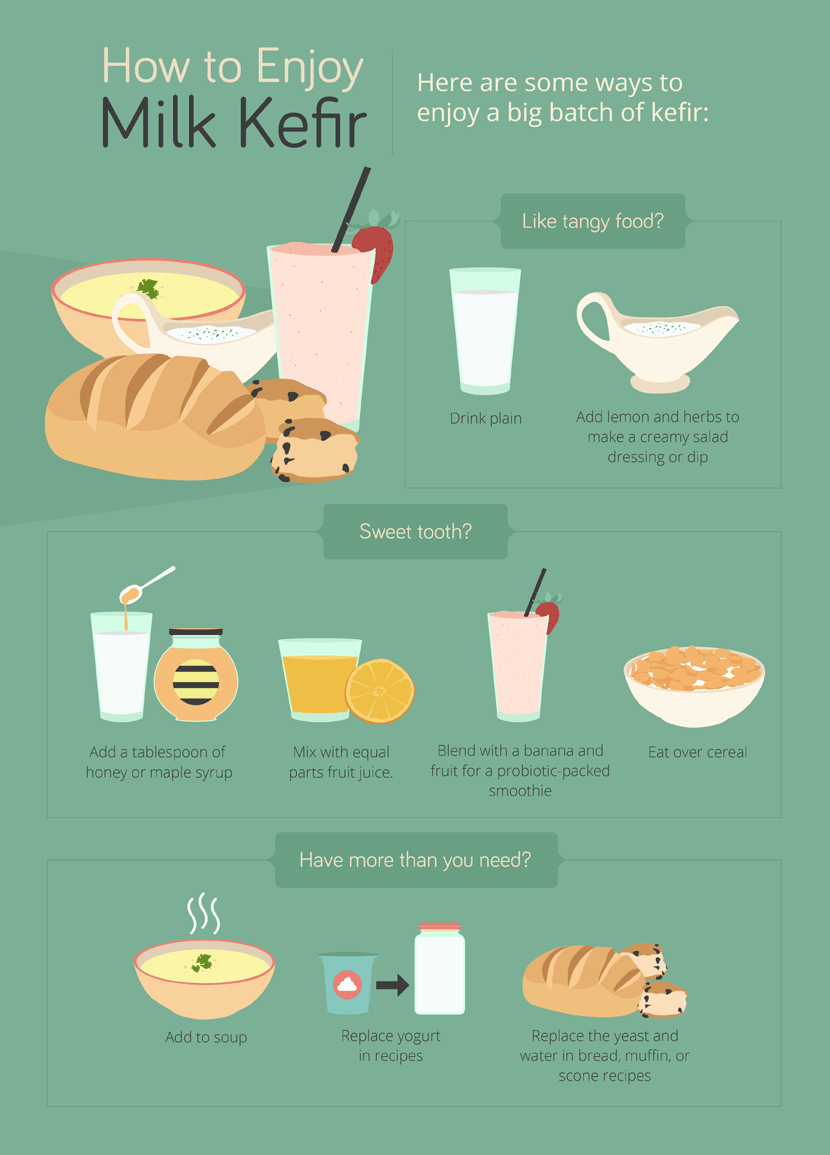How To Make Kefir
Hey Folks!
Fermented foods are my jam. I love them more than most anything, as I know how healthy and vibrant they make my body. The key to good health is maintaining healthy bacteria in our gut- it's pretty much crucial to our physical wellbeing, and as we have learned, our mental wellbeing as well.It's important to get at least 2-3 fermented foods a day, and kefir is an excellent fermented food that can be incorporated at breakfast, or any other meal of the day. I really enjoy kefir with oatmeal, or in a smoothie, as it has a nice tangy taste that gives smoothies a refreshing and creamy kick.
Today, Abby Quillen is sharing with us a recipe for kefir (both water and milk versions) , as well as its excellent nutritional benefits.

Guest post by Abby Quillen:
A healthy human gut harbors 100 trillion microorganisms representing 500 different species.1 These microflora outnumber our human cells 10 to 1.2 The good news is that most of them are our allies. They aid digestion, boost immune function, and help us absorb nutrients. It’s no wonder more and more people are taking probiotics.Luckily, you don’t need to spend a bundle on supplements to boost your gut biome. Eating probiotic-rich fermented foods – as people have done for thousands of years – has the same gut health benefits. If fermentation sounds like a scary science experiment, then it’s time to learn how to make kefir, one of the healthiest and easiest-to-make probiotic-rich foods.
Kefir 101
Kefir is tangy, mildly carbonated, fermented milk. It tastes like drinkable yogurt and has been a regular part of Russian and Eastern European diets for centuries. It’s a true superfood packed with calcium, protein, potassium, and other minerals and vitamins, and it abounds with healthy bacteria, yeasts, and enzymes.
ConsumerLab.com tests showed that a serving of store-bought kefir beats supplements when it comes to the number and diversity of probiotics. Every brand of kefir they tested teemed with “live organisms, ranging from 150 billion to 950 billion per cup – far more than found in a serving of most probiotic supplements.”3
Homemade kefir contains even more microorganisms than store-bought varieties, because most home fermenters use kefir grains that contain between 30 and 50 different strains of healthy bacteria and yeast. In one study, just one tablespoon of milk kefir contained 150 billion colony-forming units (cfu), a measure of viable bacterial or fungal cells. Compare that to most supplements, which usually contain between 3.4 billion and 30 billion cfu.
The probiotics present in kefir vary per batch, but here’s a list of bacteria strains commonly found in homemade kefir:
Lactobacillus
Lactococcus
Leuconostoc
Pseudomonas
Streptococcus
These yeast strains are common to kefir:
Candida
Torulaspora
Kluyveromyces
Saccharomyces45
The best part is that kefir is simple, fast, inexpensive, and safe to make at home. If you've struggled to ferment vegetables or yogurt in the past, don’t let those experiences scare you away from DIY kefir. The entire fermentation process only takes 24 hours at room temperature.
Not into dairy? No problem. Milk kefir can be made with coconut milk. Or you can make water kefir, a delicious and popular soda substitute. Read on to learn the basics of both.
The Difference Between the Grains
First off, milk kefir grains aren’t really grains. They’re a mixture of lactic acid, bacteria, and yeasts in a matrix of proteins, lipids, and sugars, and they contain the wonder bugs that turn milk into kefir.
Kefir grains are not available at stores, but they can be purchased online from a number of vendors. Or they can be found locally on message boards or via friends. If the grains are well cared for, they can be reused indefinitely to brew batch after batch of kefir. And they grow, which means you’ll eventually have some to share.
Kefir can also be made from a powdered starter culture, which is how it's brewed commercially. However, the grains contain more strains of probiotics and are a more economical choice, since you can use the same ones to make kefir indefinitely.
Water kefir grains contain fewer strains of bacteria and yeast than milk kefir grains, and resemble sugar rather than milk curds. Similar to milk kefir grains, they can be purchased from a number of online vendors, and they can be used over and over again.
How to Make Milk Kefir

Ingredients:
4 tablespoons kefir grains
1 quart milk
Choose one of these options:
Cow, sheep, or goat milk
Pasteurized milk works great, but avoid ultra-pasteurized and reduced-lactose varieties. The milk can contain any percentage of fat.
Coconut milk
Milk kefir grains can also ferment coconut milk. It may take the grains a few brews to adjust to non-dairy milk. Revitalize them every few days by covering with dairy milk and leaving overnight.
Equipment:
Kefir is acidic, so avoid letting it come into contact with metal, which can cause a reaction.
3 quart-sized jars with lid rings
Coffee filter, cloth, or other breathable material (enough to cover two jars)
Non-metallic colander or strainer
Rubber spatula or wooden spoon
Non-metallic mixing bowl
Instructions:
Sterilize the jars.
Depending on where you get your grains, they may be dehydrated. If so, follow the directions provided by the vendor for rehydration. If grains are resting in water, strain.
Place 4 tablespoons of grains into a jar.
Fill the jar with milk.
Affix breathable material with a jar ring.
Set the jar on the countertop out of direct sunlight or in a cupboard for 24 hours. Shake occasionally.
Strain the kefir through the colander into the mixing bowl.
Transfer the kefir into a clean jar. Smell and taste. If the kefir is thick, tangy, and slightly fizzy, it’s perfect. Affix a non-metallic lid, refrigerate, and enjoy. If sour is not your thing, read on for tips to sweeten the kefir.
Move the grains from the colander into the last jar. Repeat the process to make another batch of kefir, or cover the grains with milk and place in the refrigerator. Cold slows the fermentation, so the grains will rest there until you’re ready to make kefir again. Some experts say not to rest grains in the refrigerator regularly. However, many fermenters do because it’s difficult to keep up with drinking quarts of kefir daily. Fortunately, kefir grains tend to be quite resilient.
Kefir should not taste or smell rotten. If it does, or if anything else about it seems off, discard the liquid, rinse the grains in non-chlorinated water, and start over.

How to Make Water Kefir
Ingredients:
1 tablespoon water kefir grains
1/4 cup sugar, sucanat, rapadura, agave nectar, or maple syrup
1 quart of water
Optional flavorings
Ginger
Lemon slices
Berries, sliced in half
Dried fruit
2 teaspoons vanilla
1 teaspoon cinnamon or another dried spice
2 1/4 cup raisins
Equipment:
3 quart-sized jars with metal lid rings
Coffee filter, cloth, or other breathable material, enough to cover two jars
Non-metallic colander or strainer
Rubber spatula or wooden spoon
Non-metallic mixing bowl
Flip-top bottles (optional)
Instructions:
Sterilize jars.
Depending on where you get your grains, they may be dehydrated. If so, follow the directions provided by the vendor for rehydration. If grains are resting in water, strain.
Boil water.
Add the heated water and sweetener to a quart-sized jar. Stir until sweetener dissolves in water. Let the mixture cool to room temperature.
Add the water kefir grains.
Cover with breathable material and leave on countertop for 24 to 48 hours, shaking occasionally.
Prepare a new batch of sugar water.
Strain the grains by pouring through a colander into a mixing bowl. Transfer the finished water kefir into a clean jar.
If desired, add optional flavorings, pour into the flip-top bottles, seal, and return to the countertop for 18 to 24 hours. This second fermentation adds flavor and fizziness.
After 24 hours, strain out the flavorings, return the water kefir to the bottles, store in the refrigerator, and enjoy whenever desired.
Place the grains in the new batch of sugar water. Either repeat the process or place the jar in the refrigerator to rest for up to 3 weeks.
Water kefir grains can grow rapidly. Share any extra with friends, eat, or compost.67
Cautions
Milk and water kefir are delicious, and it's quick and easy to whip up abundant supplies. But be cautious about drinking too much too soon. Remember, these beverages contain a lot of probiotics. Your body probably isn’t used to digesting foods that contain that many good bugs. Start with small quantities (maybe just a couple of tablespoons) and increase gradually to let your body adjust. If you experience any digestive upset, slow down.
Kefir is a powerhouse beverage for most healthy people, but it may not be the right drink for people who have compromised immune systems or artificial heart valves, or who are taking certain medications. If in doubt, ask your doctor first.
People who abstain from alcohol may want to skip kefir. Milk kefir contains a very small amount of naturally occurring alcohol from the fermentation process. Water kefir that is fermented a second time with fruit contains more alcohol but usually has less than 1 percent alcohol by volume (compared to 3.5 to 10 percent for beer).8 The actual amount varies per batch by the sugar content of the fruit and the length of fermentation time.
Conclusion
The word “kefir” is said to come from the Turkish word kief, which loosely means “good feeling.”9 Once you start making it, it’s easy to understand how this substance got its name. Making kefir is an ancient art that easily fits into busy, modern lives. If you want the benefits of probiotics without the supplements, it’s time to discover this wonder drink.
Sources:
http://www.health.harvard.edu/vitamins-and-supplements/health-benefits-of-taking-probiotics
https://www.consumerlab.com/news/Probiotic_supplements_kefir_drinks/11_06_2015/
http://www.culturesforhealth.com/milk-kefir-grains-composition-bacteria-yeast
https://www.wholetraditions.com/articles/3-water-kefir-instructions
http://journals.usamvcluj.ro/index.php/agriculture/article/download/930/926
About Abby:
abby
Abby Quillen is a writer and gardener who has written for a number of publications and penned her own book titled “The Garden of Dead Dreams.” She lives in Oregon with her family where she enjoys gardening, walking and bike riding, and jotting down the cute things her children say.
This article was originally published on Fix.com on January 18,2016.

